814th Hospital Center Unit History
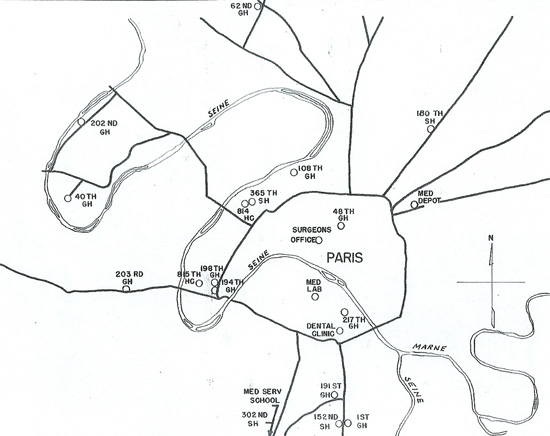
General map illustrating the location of the 814th and 815th Hospital Centers near the Seine River, Paris, France. Other Hospitals spread over the French Capital are also shown on the map.
Early History:
The story of the 814th Hospital Center began some weeks before its activation (1 Jan 45). Colonel Emery E. Alling, O-16545, MC, (CO > 48th General Hospital), was relieved of his command on 18 December 1944 and ordered to proceed to the United Kingdom Base to study the Hospital Centers established there in the course of 1944 (12th HC – 15th HC – 801st HC – 802d HC – 803d HC – 804th HC – 805th HC). He returned with the required information, enlightened to some extent, but still confronted with the task of launching a new venture on the continent. His job was to command a number of large medical units widely scattered throughout the French Capital, Paris, and vicinity, and to function during a difficult period under direct control of The Surgeon General and Commanding General of the Seine Section. The Hospital Center was set up as a kind of Group Headquarters, offering some sort of solidarity for several medical organizations located in close proximity to one another, and consolidating their efforts so that collectively they could offer superior medical services without the encumbrance of excessive administrative details (it should be noted that specialization in General Hospitals was originally designed to improve the quality of hospital care, while other measures, such as the merger of adjacent medical organizations linked with the establishment of Hospital Centers, were expected to improve overall administration and save personnel – such a “center” was intended to operate a 1000-bed convalescent organization and perform administrative services common to all hospitals in a Hospital Center, with an authorized strength of 29 Officers, 4 Warrant officers, 1 Nurse, and 255 Enlisted Men –ed).
Buildings and Quarters:
The first step toward organization was to find a suitable building in which to establish Headquarters. The site most acceptable in Paris was a five-story stone building located at 43, Rue de Villiers, Levallois, on the outskirts of the city. The building was requisitioned (with the understanding that 2 floors of it were to be continued in the use of the French families who were living there). The lower floor included a small gymnasium, dressing rooms, a game room, and quarters for a concierge. The latter were converted into a Message Center and a Telephone Switchboard room. Showers, wash bowls, latrines, close at hand on this floor, obviated its use for a small Detachment of Enlisted personnel. The game room became the Day Room. A door in the lobby opened into a large garage which proved an invaluable asset. The front court was enclosed by a high stone wall and secured by an iron gate. The third floor, after redecoration, held the offices of the Commanding Officer, Executive Officer, Adjutant, Chief Nurse, Hospital Inspector, and the Sergeant-Major. The existing spacious kitchen and pantry served as File Room, while the butler’s pantry became the Special Services & Information and Education Office. A large drawing room was turned into a convenient Conference Room. The fourth floor housed the offices of the Personnel Officer, Sanitary Inspector, Dental Coordinator, and Supply Officer. Two large rooms at the rear of the floor were reserved as quarters for Junior Officers (Senior Officers were billeted in Paris Hotels).
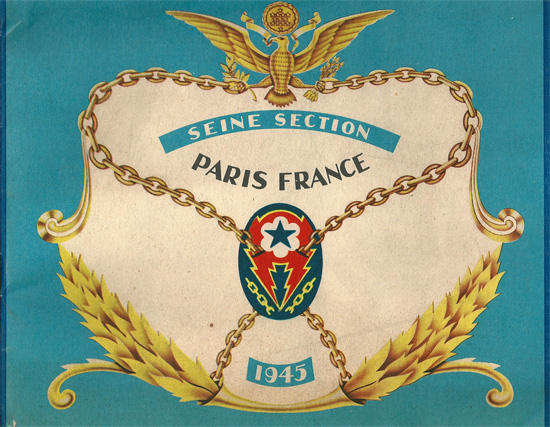
Seine Section, Paris, France booklet, prepared by the 660th Engineer Topographic Battalion (ETO), and distributed by the Seine Section in 1945 (Brigadier General Pleas B. Rogers, Commanding).
Activation:
The unit was activated as the 814th Medical Service Detachment (also designated Hospital Center), APO 887, on 1 January 1945 by authority of Organization Order No. 35, Headquarters, Com Z, European Theater of Operations, File AG 322 OP GD, dated 22 November 1944, which quoted War Department cables WAR 36085, dated 20 September 1944, WAR 49244, dated 19 October 1944, and WAR 54443, dated 29 October 1944. Organization under Column AF, T/O & E 8-500, dated 23 April 1944, was ordered.
Redesignation to Headquarters and Headquarters Detachment, 814th Hospital Center was directed in Paragraph 1, Organization Order No. 219, Headquarters, European Theater of Operations, File AG 322 OP, dated 29 March 1945, and was accomplished on 10 April 1945. Reorganization under Column AF, T/O & E 8-500, dated 18 January 1945, was completed on 11 May 1945.
The 814th HC coordinated hospital activities north of the Seine River, while its sister organization, the 815th HC did the same south of the River (it was located at 15, Avenue Victor-Hugo, Boulogne –ed). Both Centers were controlled by the Seine Base Section.
Note: more Hospital Centers on the continent went into operation such as the 811th HC and 812th HC (Jan 45) which took control of the medical installations in the Normandy Base Section, France; the 818th HC which opened in Liège, Belgium (Dec 44); and the 819th HC which was established in Bar-le-Duc, France (Dec 44).
Function of 814th Hospital Center Headquarters:
The main function of the 814th HC Headquarters was to assist its echelon components in the performance of their mission. The acceptable standard for all inspections was set at “excellent” while any condition found to be less than that was quoted “unsatisfactory”. Monthly inspections accomplished at each Hospital by all inspectors were informal and unannounced. Routine meetings of the Headquarters’ CO with his staff were held on a daily basis. Heads of the different Professional and Administrative Departments in the attached Hospitals (e.g. Registrars, Adjutants, Mess Officers, Chiefs of Professional Services, etc.) were called together in regular monthly meetings. Hospital commanders held additional and separate meetings, and a competitive spirit was fostered by means of a series of charts showing the comparative standings of the units in various activities as rated by the inspectors.
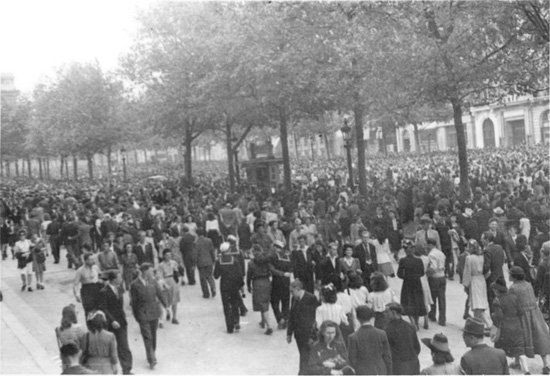
Illustration showing the public enjoying a sunday stroll on the Champs-Elysées, Paris, France.
Among some of the attached units were ‘cellular’ detachments, such as the 159th, 160th and the 161st Medical Service Detachments which provided the HC with a number of skills used in the maintenance or construction of utilities (blacksmiths, carpenters, plumbers, electricians, riggers, and repairmen). They usually consisted of 6 Enlisted Men. Other similar units were the 180th, 181st, 182d and 183d Medical Automotive Maintenance Detachments, consisting of 2 EM (mechanic, truck driver) assigned to the Headquarters’ Motor Pool.
The 365th Station Hospital, designated to provide hospital care for female and other Officers patients of the Paris area, was authorized to function as a General Hospital from 7 January 1945 onward (withdrawn 5 Jun 45). Convalescent patients and rehabilitees of all Hospitals were transferred to the 202d General Hospital while the unit was still in the process of setting up its plant.
Early March 1945 all Hospitals were placed on a 60-day evacuation policy for patients. Hospitals then used their expansion units as Rehabilitation Centers and progressed very satisfactorily in organizing this program. Hospitals which lacked the necessary space for a A & B Rehabilitation Program sent their patients to the 202d General Hospital which was devoted completely to Rehabilitation because deficiencies of the physical plant left the unit inadequate to take care of new battle casualties.
On 12 and 13 March 1945, the CO attended a conference of Communications Zone Section Surgeons and Hospital Center Commanders, convened by Major General Paul R. Hawley with the object to discuss the Hospital Center, the scope of its command, the extent of its services, its relation with Base Section Surgeons, and the development of a Standard Operating Procedure for its organization and function. The ideas and views of the individual units were to be turned into a directive which would apply to the entire Hospital Center organization.
The 48th General Hospital and later the 217th General Hospital were designated as Holding Hospitals on 13 March 1945, for the reception, triage, and dispatch to proper regional hospitals of patients arriving in the Seine Section from combat areas and other Base Sections. These Holding Hospitals received all patient loads from Hospital Trains, except PWs, female personnel, US Garrison and General Prisoners, and Psycho-Neurotic Patients. These patients were taken directly to certain Hospitals specifically designated for such treatment.
An important decision was taken on 7 May 1945 which saw the transfer from the Seine Section of the 815th Hospital Center (counterpart of the 814th HC in Paris). The 11 Hospital units which it controlled were transferred to Headquarters, 814th Hospital Center. The consolidated 814th HC’s task was to continue to provide command control, technical supervision, and advice for all attached units; to consolidate operations, services, functions, and supplies wherever possible; and to establish, maintain, or improve standards of hospital operation. With the reorganization came some changes and adaptations to meet various situations. Special treatment centers were subsequently established for: Acrylic Eye Service – Blinded Patients – Closed Ward Cases (NP patients) – Deep X-Ray Therapy – Dermatology – Maxillo-Facial Surgery – Neurosurgery – Orthopedic Shoe Manufacture – Pregnant Patients – Plastic Surgery – Severe Hand Injuries – Thoracic Surgery. Some units were reorganized and staffed with foreign personnel, such as Italian and Dutch Labor Units and Prisoners of War Treatment Wards (203d Gen Hosp), or became responsible for admission and treatment of RAMPs other than US, British, and French, (40th Gen Hosp + 217th Gen Hosp), or of Garrison & General Prisoners (191st Gen Hosp).
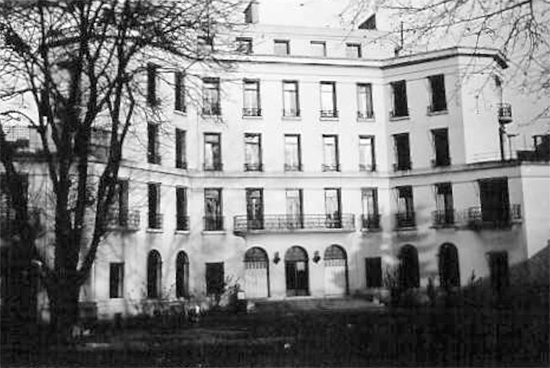
Paris, France, 1945. Illustration showing one of the buildings used by units pertaining to the 814th Hospital Center.
All transfers were made effective administratively on 27 June 1945. Transferred personnel were ordered to remain with their former units on DS pending coordination of physical transfers by 814th HC Headquarters. It should be noted that T/O & E 8-500 (dated 23 Apr 44) authorized military and civilian personnel up to an aggregate of 32. This consisted of 7 Commissioned Officers – 1 Nurse – 1 Warrant Officer – 23 Enlisted Men.
Organization:
Following units were attached to the 814th Hospital Center, pp; 11 Tr Asgmt No. 2, Hq Seine Sec, dtd 4 Jan 45:
30 December 1944
1st General Hospital (1000 beds)
40th General Hospital (1000 beds)
48th General Hospital (1000 beds)
62d General Hospital (1000 beds)
108th General Hospital (1000 beds)
190th General Hospital (non-operating)
191st General Hospital (1000 beds)
194th General Hospital (1000 beds)
198th General Hospital (1000 beds)
200th General Hospital (1000 beds)
203d General Hospital (1000 beds)
217th General Hospital (1000 beds)
16th Station Hospital
152d Station Hospital
365th Station Hospital
61st Field Hospital
159th Medical Service Detachment
160th Medical Service Detachment
161st Medical Service Detachment
162d Medical Service Detachment
180th Medical Automotive Maintenance Detachment
181st Medical Automotive Maintenance Detachment
182d Medical Automotive Maintenance Detachment
183d Medical Automotive Maintenance Detachment
815th Medical Service Detachment (Hosp Cen)
816th Medical Service Detachment (Hosp Cen)
817th Medical Service Detachment (Hosp Cen)
1 January 1945
7th Convalescent Hospital
2d Medical Museum & Arts Detachment
14 January 1945
202d General Hospital
21 February 1945
Headquarters, 1700th Labor Supervision Company
Headquarters, 1701st Labor Supervision Company
7 May 1945
16th Station Hospital
152d Station Hospital
302d Station Hospital
1st Medical General Laboratory
1st General Hospital (1500 beds)
191st General Hospital (1500 beds)
194th General Hospital (1000 beds)
198th General Hospital (1000 beds)
203d General Hospital (2000 beds)
217th General Hospital (1500 beds)
161st Medical Service Detachment
183d Medical Automotive Maintenance Detachment
9 July 1945
36th General Hospital
11 July 1945
23d General Hospital
12 July 1945
327th Station Hospital
12 September 1945
Headquarters & Headquarters Detachment, 61st Medical battalion
15 September 1945
239th General Hospital
240th General Hospital
241st General Hospital
25 September 1945
179th General Hospital
3 October 1945
Headquarters & Headquarters Detachment, 20th Medical Battalion
Headquarters & Headquarters Detachment, 343d Medical Battalion
11th Medical Depot Company
188th General Hospital
9 November 1945
1st General Dispensary (Provisional) Seine Section
Hospital Train Unit No. 1
Hospital Train Unit No. 3
Hospital Train Unit No. 25
Hospital Train Unit No. 55
237th Medical Supply Detachment
255th Medical Detachment
264th Medical Detachment
265th Medical Detachment
267th Medical Detachment
286th Medical Detachment
287th Medical Detachment
288th Medical Detachment
15 December 1945
3d General Dispensary (Provisional) Seine Section
Hospital Train Unit No. 11

Illustration of pass used by M/Sgt Richard F. Peacock, ASN 6856022, member 814th Hospital Center, Seine Section, Communications Zone, Paris, France.
The following units were relieved from assignment to the 814th HC:
200th General Hospital (22 Jan 45) – 815th Medical Service Detachment – 817th Medical Service Detachment – 1st General Hospital – 191st General Hospital – 194th General Hospital – 198th General Hospital – 203d General Hospital – 16th Station Hospital – 152d Station Hospital – 7th Convalescent Hospital – 2d Medical Museum & Arts Detachment – 161st Medical Service Detachment – 162d Medical Service Detachment – 182d Medical Automotive Maintenance Detachment – 183d Medical Automotive Maintenance Detachment (14 Feb 45) – 61st Field Hospital (16 Feb 45) – 217th General Hospital (14 Mar 45) – 190th General Hospital (15 Mar 45) – 816th Medical Service Detachment (Hosp Cen) (20 Mar 45) – Headquarters, 1700th Labor Supervision Company – Headquarters, 1701st Labor Supervision Company (7 Apr 45) – 16th Station Hospital (2 Jun 45) – 48th General Hospital (20 Jun 45) – 1st Medical General Laboratory (21 Jun 45) – 302d Station Hospital (31 Jul 45) – 202d General Hospital – 198th General Hospital – 62d General Hospital – 203d General Hospital – 217th General Hospital – 284th Medical Mess Detachment (13 Aug 45) – 21st Hospital Train Unit – 24th Hospital Train Unit – 43d Hospital Train Unit (18 Sep 45) – 108th General Hospital (28 Sep 45) – 1st General Hospital – 36th General Hospital (1 Oct 45) – 23d General Hospital (6 Oct 45) – 40th General Hospital (8 Oct 45) – 20th Medical Battalion (20 Oct 45) – 931st Medical Blood Transfusion Detachment – 932d Medical Blood Transfusion Detachment – 933d Medical Blood Transfusion Detachment – 934th Medical Blood Transfusion Detachment (31 Oct 45) – 2d Medical Museum & Arts Detachment – 10th Medical Laboratory – 17th Hospital Train Unit – 127th Medical Mess Detachment – 129th Medical Mess Detachment – 130th Medical Mess Detachment – 131st Medical Mess Detachment – 133d Medical Mess Detachment – 159th Medical Service Detachment – 161st Medical Service Detachment – 162d Medical Service Detachment – 169th Medical Service Detachment – 182d Medical Automotive Maintenance Detachment – Headquarters & Headquarters Detachment, 343d Medical Battalion – Headquarters & Headquarters Detachment, 810th Hospital Center – Headquarters & Headquarters Detachment, 816th Hospital Center – Headquarters & Headquarters Detachment, 817th Hospital Center (15 Nov 45) – 188th General Hospital (22 Nov 45) – 152d Station Hospital (3 Dec 45).
| Military Staff – 814th Hospital Center (30 Jun 45) Assigned Officers |
||
| Commanding Officer | Emery E. Alling, MC (O-16545) | Colonel |
| Executive Officer | James T. Hall, MC (O-357057) | James T. Hall, MC (O-357057) |
| Chief Professional Services | Howard B. Kellogg, MC (O-461831) | Lt. Colonel |
| Sanitary Inspector | Stewart L. Tuckey, SnC (O-496837) | Major |
| Supply Officer | Charles S. Urso, QMC (O-1579246) | Major |
| Adjutant, Detachment | ||
| Commander, Special Service | ||
| Officer, Public Relations Officer | Wallace W. MacDonald, MAC (O-1542952) | Captain |
| Assistant Personnel Officer | Ray B. Behner, USA (W-2102669) | Chief Warrant Officer |
| Nurse Administrative | Kathryn S. Witmer, ANC (N-724164) | Major |
| Attached Officers | ||
| Officer in Charge of Bakery | David M. Gale, MAC (O-1533784) | Captain |
| Jewish Chaplain | Isiah Rackovsky, ChC (O-521858) | 1st Lieutenant |
| Information & Education Officer | Edgar A. Linden, MAC (O-2011814) | 2d Lieutenant |
| Personnel Officer | Mildred B. Sellman, WAC (L-116000) | 1st Lieutenant |
Assigned Enlisted Personnel
(included different occupations and functions: personnel – supply – motor – statistics – promotions – clerk typist – special service – interpreter – athletics – courier – message center – mail clerk – supply clerk – driver – chauffeur – switchboard operator – night service – civilian personnel, etc.)
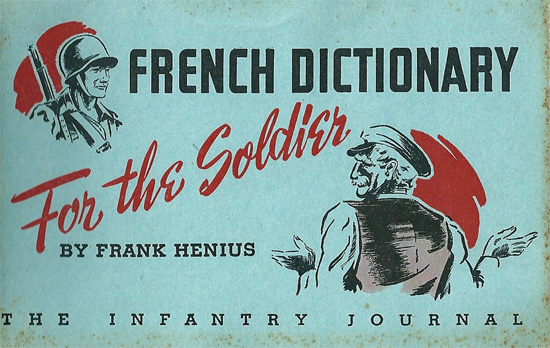
“French Dictionary for the Soldier”. Pocket edition by Frank Henius, published by the Infantry Journal Inc. June 1944. Widespread booklet useful and helpful to the US Armed Forces and Military Administrators.
Attached Enlisted Personnel
(sanitary inspection – special service – supply – bakery – courier – personnel – pay roll – carpenter – plumber – mechanic – driver – administrative clerk – mail clerk – Chaplain’s assistant, etc.)
| Civilian Personnel | |
| Typist | 1 |
| Switchboard Operator | 2 |
| Charwoman | 6 |
| Handyman | 1 |
It was felt that following tasks were superfluous – according to the T/O there was room for one Lt. Colonel, DC, Dental Staff and one Major, VC, Veterinary Staff. Headquarters suggested that it was better to fill this vacancy by respectively a MC Chief of Professional Services and a QMC or MAC Major to handle supply problems.
Total military strength of the Command at 30 June 1945 was:
| Officers | 1,738 |
| Enlisted Men | 5,953 |
Changes in Command and Organization:
On 15 September 1945, Lt. Colonel James T. Hall took over command. He was transferred to the 188th General Hospital 7 October 1945.
On 25 September 1945, Colonel Emery E. Alling was transferred to the 191st General Hospital.
On 3 October 1945, Colonel Thair C. Rich assumed command of the 814th HC, with Lt. Colonel Edward J. Doyle as Executive Officer.
On 13 November 1945, Lt. Colonel Edward J. Doyle assumed command. He was subsequently transferred to Headquarters US Forces in Austria 22 November 1945.
Consolidation, Reassignments, Redeployments:
The period from 1 July 1945 to 31 December 1945 was one of continual change with the turnover of both units and personnel according to the procedures and policies of Redeployment. As of the first of July, the 814th Hospital Center directed the activities of 10 General Hospitals and 3 Station Hospitals; whereas by the end of 1945, there remained only 2 Hospitals in actual operation, one General (239th Gen Hosp) and one Station (365th Sta Hosp), plus two additional Hospitals in the process of staging.
The most notable change affecting the HC was the consolidation with The Surgeon’s Office that became effective 3 October 1945. Both Headquarters maintained their identity and separate functions, but gradually the line of demarcation dissolved to the point that though they were different in name, in reality the two organizations developed into a single, well-knit, functional Headquarters. Colonel Thair C. Rich, MC (Surgeon, Seine Section), was also the CO of the 814th Hospital Center. Lt. Colonel Edward J. Doyle, MC (Deputy Surgeon, Seine Section), acted as the XO for the 814th HC. After Colonel Rich’s departure, Lt. Colonel Edward J. Doyle assumed the role of both Surgeon and Commanding Officer (almost every Officer in the combined Headquarters had a dual function at the time).
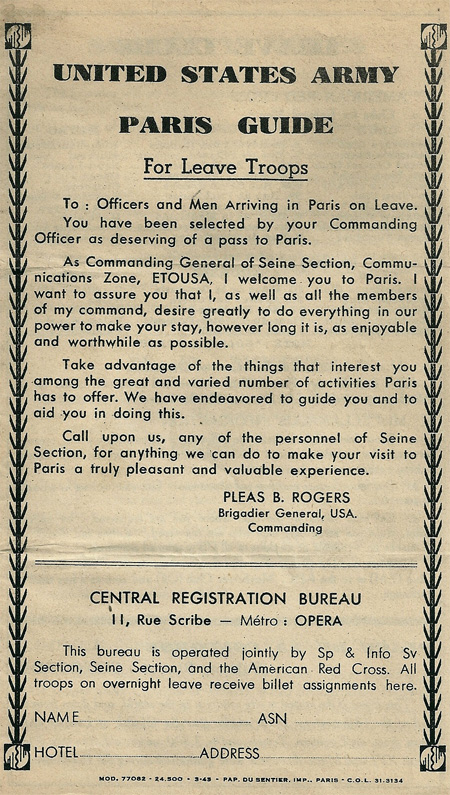
Leaflet specially distributed by the Seine Section addressed to Officers and Enlisted Men arriving in Paris on leave. This also applied to convalescent and military personnel residing in Paris, France. The document printed in March 1945 and signed by the CG, Seine Section, Brigadier General Pleas B. Rogers, provided servicemen with plenty of useful information such as a Leave Clubs, Army Exchanges, religious services, security instructions, traveling by subway, purchases, athletics, entertainment, and miscellaneous information.
Additional Hospitals were relieved from attachment with the Center, and in the first phase of Redeployment, 45 Officers and approximately 1,000 EM were reassigned, 128 requests for discharge and 194 requests for leaves and furloughs were processed through the headquarters office. In September, another 150 Officers and 250 Enlisted Men were reassigned. Transfer of all Medical Corps Officers was carried out (after consolidation of both Headquarters), while Readjustment and Redeployment procedures were further continued. Nevertheless regular monthly inspections were held throughout the transition period for all medical units still assigned to the Seine Section and attached to the 814th Hospital Center.
A number of Nurses were redeployed during summer, they were sent to the 198th and 202d General Hospitals preparatory to their transfer direct to the Pacific Theater. Some Hospitals were replaced by others, involving considerable shifting of ANC personnel with Nurses sent on DS with the various hospital organizations in Paris. Nurses bound for the Pacific attended the Medical Field Service School courses on Tropical Medicine. 97 Nurses from the marshalling area at Reims reported for Detached Service in July for varying periods of time. After leaves to the United Kingdom, the French Riviera, and passes to Brussels, Belgium, additional leaves to Switzerland were introduced, beginning in August 1945.
End August Nurses with the highest ASR Score were flown home and others were reassigned to the 40th General Hospital for shipment to the United States by boat. In September, another 50 high point Nurses from the Seine Section were transferred by air to the Marseille Assembly Area for immediate shipment to the Zone of Interior, and 52 Nurses from the Calas Area replaced them. Following the consolidation, some changes in ANC personnel took place, with the appointment of Captain Margaret A. Pate, ANC as Director Nursing Service, while Major Kathryn S. Witmer (Chief Nurse > 814th Hospital Center) was reassigned to the 166th General Hospital for return to the USA. A total of 289 Nurses were redeployed to the ZI with the 23d, 36th and 1st General Hospitals in October 1945. New arrivals, such as the 188th General Hospital, with a complement of 83 Nurses, solved some shortages by reassigning 27 Nurses to other units. Later, 25 Nurses were transferred to Army of Occupation units in Germany.
Regular promotions were still in progress during the period, while transfers continued, and reassigned personnel were detached to assist other units. In December, 142 Nurses from various units departed the Seine Section for the Nurses’ Staging Area No. 1, Camp Philip Morris, for immediate shipment to the States. The 191st General Hospital departed for Le Havre, for shipment to the Zone of Interior with 18 Nurses assigned, 23 December 1945.
On 24 December 1945, 1st Lieutenant Bertha J. Fanjoy, ANC was appointed Director of Nursing, Surgeon Section, Headquarters Seine Section replacing Captain Margaret A. Pate, ANC, who was assigned to the 124th General Hospital. 14 Nurses arrived at the 239th General Hospital as replacements, after debarking at Le Havre. On 30 December 1945, 76 Nurses arrived in Paris from Le Havre en route to Marseille, Antwerp, and Frankfurt. 31 Nurses left the Seine Section for Camp Philip Morris 7 January 1946 for transhipment to the United States.
With the closing down of several Hospitals, it was necessary to combine some medical facilities, such as General Dispensaries and Dental Services.
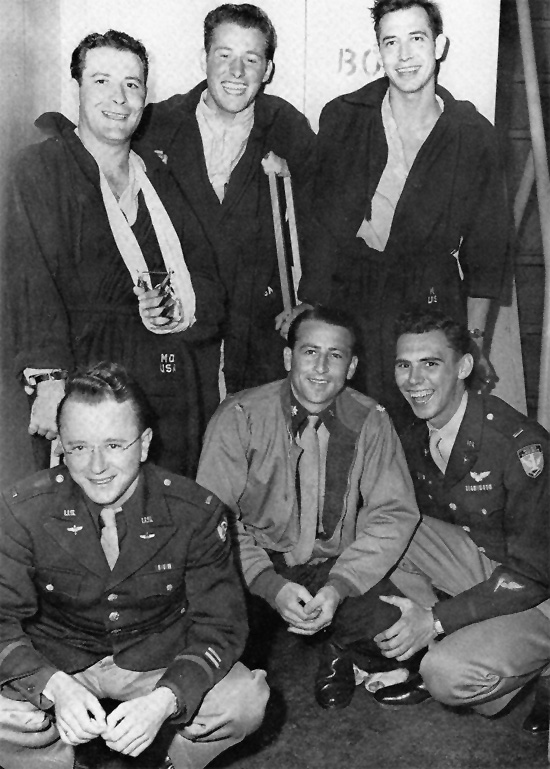
Happy faces! Infantry, Armored, Airborne, and Army Air Force Officers earn a trip home. After being wounded in action, they received the necessary preliminary treatment and care, and are now on their way to the Zone of Interior for either rest or further treatment.
Transportation:
Transportation was part of the responsibilities of the HC. The T/E allowance of vehicles was totally inadequate (it provided for two ¾-Ton Weapon Carriers and one 1 ½-Ton Cargo Carrier). A recommendation from Headquarters requested the absolute minimum to be:
1 x Sedan (for use by the Hospital Center Commander)
1 x Sedan (for use by the Executive Officer and Inspector)
2 x ¾-Ton Command & Reconnaissance Trucks (for use by the Inspectors)
3 x ¼-Ton Trucks (for use by the Message Center and passenger requirements)
3 x ¾-Ton Weapon Carrier Trucks (for cargo transportation requirements)
1 x 2 ½-Ton Cargo Truck (for cargo transportation requirements)
Supplemental transportation for the Hospital Center had to be obtained from attached units (borrowed) and the Transportation Section of the Seine Section to which the 814th HC was attached. Headquarters suggested an increase of the vehicle allotment.
4 Ambulances from the following hospitals: 191st, 194th, 198th,and 217th General Hospitals were stationed at the 217th General Hospital for evacuation of patients. All other units attached to the Center had to hold 4 ambulances available for any call by the Evacuation Officer of the 217th General Hospital.
Supplies:
Full cooperation was received from the Quartermaster Corps who gave priority to Hospitals (HC units) for clothing and some equipment for patients who arrived from forward hospitals in dire need of these items. Although the Depot in town (M-407, operated by the 11th Medical Depot Company –ed) attempted to have a special stock for the Hospitals, demand was so heavy that the organization had to consolidate all requisitions for items not received locally and make trips to other depots where the items could be located.
A delivery service was set up for the disposition and pickup of Baggage and Effects to and from the QMC Effects Depot, approximately 90 miles away.
Conservation of Manpower and Material:
In January 1945 all attached General Hospitals were directed to reduce their Enlisted personnel to a minimum of 400 EM instead of the 450 authorized. This resulted in a total saving of 600 Enlisted Men, mostly Technicians in the units. Station Hospitals and smaller units were ordered to reduce their Enlisted manpower by a minimum of 20 percent. The loss of American personnel was compensated by hiring additional French civilian labor and increasing the number of German PWs used in the various units.
Housing, Water Supply, Bathing Facilities, Laundry:
While Officers and EM were billeted in permanent type structures, the Enlisted personnel of the 202d General Hospital and 302d Station Hospital were accommodated in tentage. Sanitary facilities and floor space per man was conform to Army Regulations. Permanent-type buildings used for billets were Hotels, School buildings, Châteaux, and parts of the various Hospital Plant facilities.
Water Supply for the various plants was adequate and satisfactory. When the water supply was not drawn from an approved source, chlorination was practiced. A chlorinator was installed at the 40th General Hospital, while Lyster Bags were used at the 202d General Hospital and 302d Station Hospital, since the water supply of these units did not come from a source approved by the Seine Section Surgeon.
Bathing and Laundry facilities at all Hospital Plants were adequate. Laundry was either accomplished by QMC Laundry units or by French civilian firms. Laundries were present at some sites, and QMC Laundries were used at other sites lacking these services.
Food and Messing:
Kitchen facilities were available at the majority of Hospitals. Marked improvements were accomplished in the existing cooking and messing facilities and arrangements at the 191st, 194th, 198th, and 202d General Hospitals. Excellent Mess tents and kitchens were constructed at the 40th and 108th General Hospitals as part of their expansion units. The 202d General Hospital demonstrated originality and initiative in adapting their existing facilities to tentage. New Mess halls for ambulatory patients and Detachment personnel were constructed at the 62d and 203d General Hospitals, respectively. Rations were excellent and adequate. Food was issued according to the Continental Menu, plus a Hospital Supplement for patients, as published and instructed by The Office of the Quartermaster, ComZ. Fresh frozen meats, fresh eggs, fresh fruits and vegetables were available in adequate quantities.
The 814th HC Bakery was started in March 1945 in order to provide more palatable bread for hospital patients. The bakery, consisting of 1 Officer and 9 Enlisted Men, took over management of an existing French bakery, and produced a French-style bread from QMC Ration ingredients. Requests from units outside the Center were equally met. In June 1945, the bakery was servicing a total of 43 units in the Seine Section, producing 10,000 lbs of bread daily.
Sewage was disposed of through the municipal system except at the 202d General Hospital (under tentage) where 2 septic tanks were built to dispose of raw sewage. Edible garbage was either sold to civilian contractors or burned or hauled to municipal dumps. Paper was salvaged (bread paper bags) as well as rags (for cleaning purposes) and tin cans. Insect control was adequate and DDT dusting powder was effectively used to control fleas and straw mites (still limited use of straw mattresses).
V.D. Control:
The program for avoiding Venereal Disease included a series of lectures upon the religious, social, and disabling aspects of the problem. Mechanical prophylactic devices were always available for men going on a pass. Lists of Pro-Stations in Paris were maintained on the Detachment Bulletin Boards.
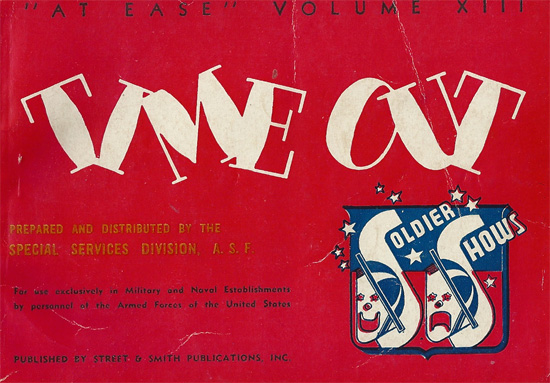
“At Ease”, Volume XIII,
Professional Medical and Surgical Services:
The problems of evacuation and triage were discussed with the Chiefs of Surgery. The new Rehabilitation Program of surgical patients was a subject of interest in view of the new plans that were just getting well under way at most Hospitals of the Center. The 40th, 62d and 108th General Hospitals were the only ones having facilities for Class A & B patients and excellent centers for the purpose were being developed there. The 48th General Hospital transferred all A & B patients to these hospitals but carried on a program for bed patients.
An increasing number of patients came into the Paris area by air with a corresponding decrease in those arriving by Hospital Train. So, most of the triage was now being done at the 180th General Hospital (rather than at the 48th Gen Hosp).
The great number of RAMPs, most of whom were nutritional cases, made it necessary to place them in peripheral hospitals where they were regrouped for evacuation to the ZI. The 48th General Hospital remained responsible to see that the evacuees were in proper condition for air travel to the ZI and therefore these patients were sent through this Hospital to the Air Holding Unit at the 1st General Hospital. It was noted that many recovered Allied military personnel cases received poor, inadequate surgical treatment, before arrival at US medical installations, at the hands of German Medical Officers, some times they were treated by captured American Medical Officers without appropriate equipment or supplies. The return of many RAMPs caused quite a backlog to the hospitals.
In June 1945 the closing of some Hospitals and the problems arising out of Redeployment caused more concern to Headquarters. The Center was repeatedly asked to assist hospital units losing Specialists to help finding replacements to cover the services during the period of Readjustment. There was considerable inconvenience at times, but fortunately no actual lack of medical care. It was anticipated that medical personnel from closing Hospitals would be placed on DS with operating Hospitals until they were redeployed.
Several refresher courses were duly programmed and accompanied by lectures, clinics, ward rounds, and other related activities.
Nursing History:
The Nursing Section of the 814th Hospital Center officially began to function 1 January 1945 with Major Kathryn S. Witmer, ANC (formerly Chief Nurse > 48th Gen Hosp) in charge, and 1st Lieutenant Francis Hellman, MC, on Detached Service from The Surgeon’s Office, Seine Section, assisting.
During the months of January and February the new units, were oriented and given assistance in setting up Nursing Services. Other units were equally visited. Formal inspections were made and reports rendered on all the installations controlled by the Hospital Center.
On 13 February 1945, the 815th Hospital Center began functioning and took over a number of Hospitals (1st, 191st, 194th, 198th, 203d General Hospitals and the 16th Station Hospital). The 815th HC remained operational until 13 May 1945 when these units again reverted under the jurisdiction of the 814th Hospital Center. Due to the increased workload, the Nursing Office received additional support from 1st Lieutenant Agnes Des Marais, ANC, attached from the 48th General Hospital.
Nursing Services were augmented for varying periods of time by Nurses from the 189th, 190th, 192d, 193d, 195th, 200th, 226th, 227th General Hospitals, the 327th Station Hospital and various Hospital Trains.
The 109th General Hospital was officially disbanded 15 March 1945 and its Nurses assigned to the Hospitals where they had been on DS. Because of shortage of ANC personnel and the heavy patient load, many organizations found it necessary to have the Nurses work a 12-hour day for a period of several months.
7-day leaves to the United Kingdom were started 5 March 1945, and to the French Riviera 1 May 1945. 72-hours passes to Brussels and the “Normandy Club” in Paris were also introduced in May to compensate for the heavy workload.
Recommendations for promotion to First Lieutenant of all Second Lieutenants who had had a rating of ‘excellent’ for the three months were submitted by 15 June 1945; with all Nurses interviewed and papers processed and forwarded.
Dental Service:
Although in being since end of December 1944, the Dental Section only became operative on 6 January 1945. Dental Service had only been installed in 8 of the General Hospitals, 1 Station Hospital, and the single Convalescent Hospital.
The 194th and the 198th General Hospitals had arrived in the area without proper T/E and were occupying Schools. Therefore some modifications and alterations were planned and 2 Chests No. 60 provided to each unit so that limited dental treatment could be afforded patient and unit personnel. The additional dental personnel (without work) were placed on TD with the 7th General Dispensary at the Eastman Clinic. As the 200th General Hospital operated no Dental Service, its Dental Officers were utilized by the 7th General Dispensary. The 190th General Hospital never did operate actively in the Paris area and also assigned dental personnel on DS with the 7th General Dispensary. The same course of action was taken by the 202d General Hospital which also arrived in the area without proper dental equipment. The 16th Station Hospital was unable to set up a service because of absence of the Dental Officer (sick in England). The Center secured a Dental Officer for TD with the Hospital, pending assignment of another Officer. The 152d Station Hospital did not function as a Hospital, but operated as the “ETO Blood Bank”. Due to its proximity to the 1st General Hospital no dental service was set up, with the Dental Officer being placed on DS with the 7th General Dispensary.
Restorative dentistry within the Center increased in April 1945 due to the closer cooperation of allied services in reporting patients to the Dental Service for examination, and to the extended hospitalization period of the patients.
Redeployment policy of hospital units, shortages on T/O due to release of personnel on Points or Rotation, extra requirements of the Paris Dental Dispensary, led to a few problems as hospitals had to continue providing the maximum service possible with the remaining personnel assigned.
Welfare, Social Service and Recreation:
A Day Room was constructed with the necessary items such as games, cards, and reading material. Normal distribution of theater tickets (shows for Allied personnel) in Paris was enjoyed, and in addition, the Enlisted Men could frequent civilian theaters and other places of interest in the Capital City. Visits to parks, churches, historical monuments, were encouraged and sponsored. A special program of illustrated lectures on “Life in 17th Century France” was presented for patients. Daily popular radio programs went from hospital to hospital, and tours of Paris by means of sightseeing buses were most beneficial to patients.
A gymnasium was available and conveniently located in the Headquarters building, and a covered tennis court was also at the premises. There was a softball team that organized and played tournaments. Volley ball and horse shoe were equally available. Two dance bands were available to Seine Section units.
Information and Education programs functioned smoothly with a 2-hour weekly program of Round-Table discussions. News Bulletins, hometown papers, Yank, The Stars and Stripes, Army Talks, as well as popular periodicals were maintained in the Special Services Office. A PR Section functioned in conjunction with Special Services. Inter-Hospital athletics were initiated including plays and tournaments for attached units.
Policy Files – Organizational Outline of the 814th Hospital Center:
| Commanding Officer – MC | General Policy |
| Executive Officer – MC | General Administration |
| Professional Supervisor – MC | Professional Services |
| Medical Inspector – MC | Hospital Administration, Training, and Physical Condition |
| Sanitary Inspector – SnC | Mess, Billets, General Sanitation |
| Supply Officer – QMC | Med & QM Supply, Utilities, and Transportation |
| Adjudant – MAC | Headquarters Administration |
| Adjudant – MAC | Personnel |
| Adjudant – MAC | Nursing Services |
| Hospital Center Medical Consultants |
Here follow some of the major policies and procedures in effect at the 814th Hospital Center.
Zone of Interior Patients:
General Hospitals of the Seine Section were required to furnish the Air Holding Unit located at Hospital Plant No. 4322 with nominal lists of patients transferred to the Air Holding Unit and instructions for any special treatment needed by these patients en route to the Zone of Interior. Departure took place at Orly Airfield, south of Paris.
Recovered Allied Military Personnel (RAMP):
It occurred that enemy patient personnel was sometimes discovered during processing of Recovered Allied Military Personnel in Seine Section Hospitals. It was therefore ordered that any such enemy patients were to be formally transferred to the Prisoner of War Section of the General Hospital Plant No. 4316 for further treatment and disposition.
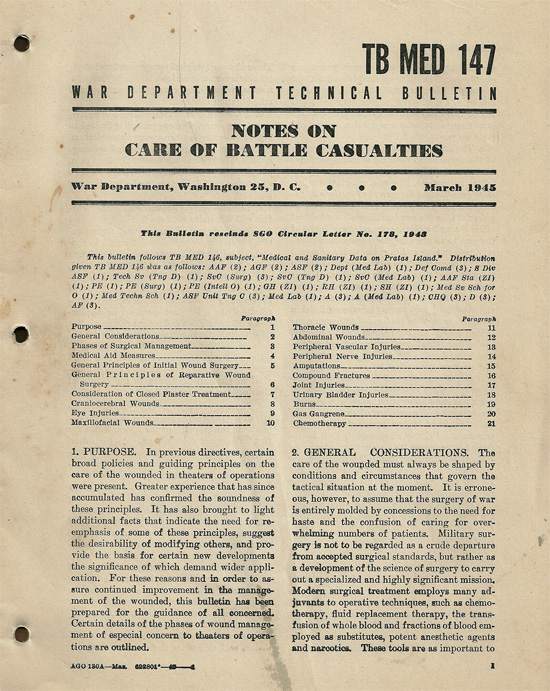
TB MED 147 – War Department Technical Bulletin, “Notes on Care of Battle Casualties”, March 1945. This 18-page bulletin (following TB MED 146 “Medical and Sanitary Data on Pratas Island”) covers general considerations, surgical management, aid measures, and general principles of initial and reparative wound surgery.
British and Canadian Personnel:
Name, rank, serial number, and diagnosis of all hospitalized British or Canadian personnel who were placed on or moved from the seriously ill list and all deaths of such personnel were to be reported by telephone to the British Army Staff, 63, Rue du Faubourg St. Honoré, Telephone: ANY2840, attn. Major Hargreaves.
Disposition of Russian Nationals:
A plan was being worked out in June-July 1945 to concentrate all Russian nationals now treated at US Army Hospitals in one single General Hospital outside the Seine Section. Until such a plan was operative, small numbers of patients could be disposed of by transfer to a Russian Hospital at the Cité Universitaire. Authority for disposition procedure emanated from Lt. Colonel Letournow, Chief of Russian Medical Service, Russian Military Mission to France. The chief contact at the Cité Universitaire was Dr. Roumianyev who did not speak English. Duty cases thus disposed were flown to Russian territory from a separate airstrip near Versailles.
Dutch Guards:
The training, housing, and general supervision of Dutch Guards were a command responsibility and received the careful attention of the CO. Dutch Guards were to be instructed in military discipline, to show proper military courtesy, and in the handling of US arms.
Italian Labor Company Personnel:
Italian Labor Company personnel who were attached unassigned to the Detachment of Patients in Seine Section Hospitals, when ready for duty, were disposed of by transfer to a Seine Section Italian Labor Company. The Military Labor Service Section, Headquarters, Seine Section, France, was to designate a specific unit to which an individual could be assigned by hospital orders.
Disposition of Patients:
The Commanding Officers of the respective Center Hospitals were urged to dispose of patients who were ready for duty in the speediest possible manner. Emphasis was placed on prompt disposition of all types of patients, particularly RAMP patients and cases boarded or about to be boarded to the Zone of Interior.
Self-Inflicted Wounds:
Military personnel suspected of Self-Inflicted Wounds could be evacuated to another General Hospital in the Communications Zone (outside the Seine Section), but could not be evacuated to the Zone of Interior without an investigation. Such individuals (in case of combat troops) when ready for duty, were to be returned through the Ground Forces Reinforcement Command, with a statement that they were returning to their proper unit, for duty and investigation.
Disposition of Amputated Extremities:
The Graves Registration Service was solely concerned with the disposition of remains. It was therefore the responsibility of the individual Hospital commanders to dispose of amputated extremities and other human material removed from live individuals by injury or operative procedure. Proper disposition had to be made through burning completely in a suitable incinerator or by burial.
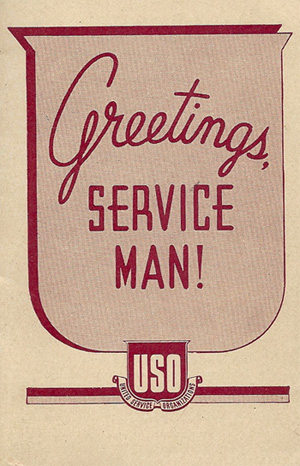
“Greetings, Service Man!” – small pocket size booklet prepared by the YMCA (Young Men’s Christian Association) and the Salvation Army, with the help of the Foreign Missions Conference of North America, 1943, and distributed by the USO (United Service Organizations) to military personnel who were to be sent overseas. Filled with a number of tips for the soldier.
Shock Therapy Centers:
The Office of the Chief Surgeon designated the 108th General Hospital and the 191st General Hospital as Centers for Shock Therapy. The type of treatment concerned was only to be administered to psychotics. All patients that required this therapy were to be transferred to one of the above designated centers.
Personnel Roster:
| Enlisted Personnel (incomplete) | ||
| Andrew, Earl E. | Antle, Phillip J. | Avery, Randolph F. |
| Barnes, Donald | Biggs, Edwin T. | Blackburn, Floyd J. |
| Bollens, Harold R. | Briegel, Frank B | Burney, Gaylen D. |
| Burrows, Gurney E. | Byars, William B. | Byrd, Charles W. |
| Carte, Ray | Clements, Richard | Coleman, Robert J. |
| Cornwell, Charles C. | Crupper, John T., Jr. | Dale, Stanley A. |
| Dial, Frank | Downs, Calvin L. | Drahota, Stanley |
| Dubrow, Edward C. | England, Rudolph | Evanovich, Laddie |
| Felts, Paul E. | Fox, William C. | Gastineau, Richard L. |
| Grady, Jack E. | Hayes, John K. | Heckart, Clyde O. |
| Heymers, Adolph C. | Jaeger, Gerhardt | Kattas, George |
| Key, Edward J. | Lawson, Clarence L. | Lebe, Irving |
| Lester, Kenneth E; | Magruder, James B. | Marner, Patrick J. |
| Marshall, Roscoe F. | Matras, John | McGrath, Orville C. |
| McColl, Roderick | McDaniel, Max A. | McMahon, Carter W. |
| Meyer, Fred C. | Mittermann, Emil F. | Mlin, Lionel J. |
| Mongiat, Ferrucio J. | Montedonico, Edward L. | Moraczewski, Stephen A. |
| Morrison, Warren F. | Olson, Thorsten V. | Owen, Travis O. |
| Peacock, Richard F. | Peterson, Alfred C. | Pettersen, Chester R. |
| Pirch, Harold W. | Quarnstrom, Theodore E. | Rice, Arbie L. |
| Rosenberg, Max | Schaake, Albert C. | Schaefer, Gerard J. |
| Scherbak, Nick J. | Schuldt, Melvin F. | Shannon, Harry D. |
| Shaw, Walter M. | Skelton, Erskine F. | Smith, Alfred E. |
| Stamler, Norman J. | Steinkamp, Frederick W. | Stone, Abraham |
| Storch, Herman J. | Timlick, Clayton | Utecht, Alois J. |
| Vanderveen, Charles T. | Wentworth, George E. | Wills, John D. |
| Winders, Eugene J. | ||
We are particularly grateful to Lynne Peacock Bell, daughter of M/Sgt Richard F. Peacock (ASN:6856022) who served with subject unit, and to Lois Shiner Montbertrand, daughter of Capt. Robert L. Shiner (ASN:O-369560) who served with the 203d General Hospital in WW2. Both ladies provided us with lots of data and information related to the 814th Hospital Center. Our most sincere thanks for their kind assistance. Additional data and a complete personnel roster are still welcome.
